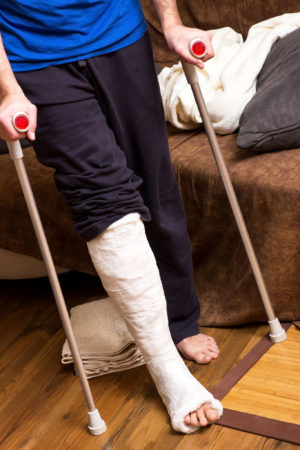 If you suffer a foot fracture or undergo an operation on your ankle, you may need to be non-weight bearing or limited-weight bearing for some time. Casts and walking boots can help to take pressure off the foot, but sometimes even those devices place too much stress on the foot. Those cases often call for crutches. You’ve probably seen someone at school or on television getting around on crutches, but they aren’t as easy as some people make it look. Below, we discuss how to safely learn how to use and get around with crutches.
If you suffer a foot fracture or undergo an operation on your ankle, you may need to be non-weight bearing or limited-weight bearing for some time. Casts and walking boots can help to take pressure off the foot, but sometimes even those devices place too much stress on the foot. Those cases often call for crutches. You’ve probably seen someone at school or on television getting around on crutches, but they aren’t as easy as some people make it look. Below, we discuss how to safely learn how to use and get around with crutches.
Starting To Use Crutches
If you’ve been given crutches by your foot specialist or primary care physician, it is probably a good idea to have a friend or family member nearby when you’re first getting the hang of them. In the event something goes wrong, they’ll be able to help get you back on your feet. You’re going to feel uncoordinated or clumsy at the outset, but with a little practice, you’ll be able to master the technique.
One of the most important factors in insuring that you are successful getting around on crutches is that they are positioned to the correct height. When you’re standing straight, the tops of the crutches should rest about 1-2 inches below your armpits. The majority of people who have trouble getting around on crutches at the beginning do so because the crutches aren’t fitted well to their height. Aside from the top of the crutches, you should also adjust the hand grips of the crutches to be in line with the top of your hip.
As you move, your elbows should be slightly bent when you hold the hand grips, and more of your weight should be channeled through your hands, not your armpits. Putting too much weight on your underarms can lead to shoulder issues or damage blood vessels in the armpit. When walking, lean forward slightly and put your crutches about 1-2 feet out in front of you. Instead of stepping on your injured foot, shift your weight onto the crutches while your uninjured foot swings forward for its next step. Land with your healthy foot, reach your crutches back out in front of you, and begin the process again.
Crutches and Stairs
If you’re like most people, you have stairs somewhere in your house that you need to go up and down on a regular basis. Even if you don’t have stairs at home, odds are you’ll encounter them at work, school or when you’re out and about. So how can you best traverse stairs with only one leg and a pair of crutches?
Assuming you’re going upstairs, grab the handrail with one hand and put both crutches under your armpit on the other side. Lead with your good foot, with your injured foot raised behind you. Bring your crutches up to the next stair, shift your weight forward and use the crutches and handrail for support as you bring your injured leg up to rest on the stair. Repeat this process until you’ve climbed all the stairs. You’ll use the same technique to go down the stairs, although some people find it easier to have their injured foot raised out in front of them instead of tucked behind them.
If you feel unsteady or unsafe, some people find it easiest to sit down and scoot up and down each step as necessary. You should always have your back facing the staircase when scooting up or down stairs.